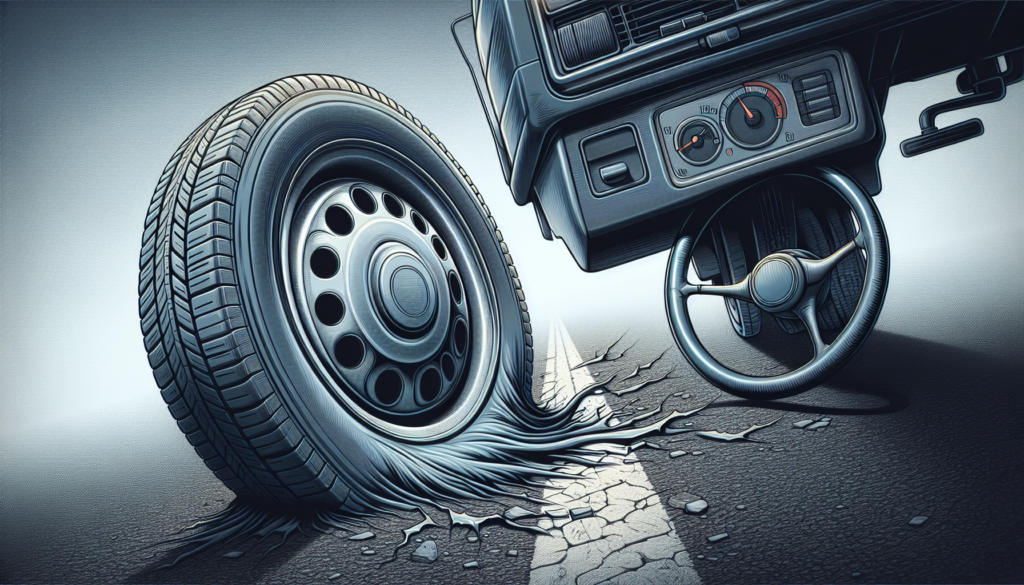Imagine cruising down the road, wind in your hair and a smile on your face. Suddenly, you feel a slight tug on the steering wheel, a flutter of unease in your gut. Could it be that something as seemingly insignificant as low tire pressure could be causing this unsettling feeling? The answer, my friend, is a resounding yes. Low tire pressure is not to be underestimated, as it has the power to throw off your steering, compromise your control, and turn joyful drives into nerve-wracking experiences. Buckle up and join me as we explore the consequences of low tire pressure and the importance of maintaining those precious rubber companions properly.

Effects of Low Tire Pressure on Steering
Increased Tire Wear
Driving with low tire pressure can cause increased tire wear. When the tire pressure is not at the recommended level, the tires can wear out unevenly. This can result in uneven tread wear, decreasing the overall lifespan of the tires and requiring more frequent replacements. Additionally, underinflated tires may be more prone to cupping, where small, uneven patches of wear develop on the tire’s surface, further compromising their performance and longevity.
Reduced Traction
One of the major effects of low tire pressure on steering is reduced traction. When the tires are underinflated, the contact patch between the tire and the road decreases. This reduced contact area means that the tires have less grip on the road, especially during cornering or when driving on wet or slippery surfaces. Reduced traction can significantly impact the vehicle’s ability to navigate turns safely, increasing the risk of skidding or losing control.
Poor Handling and Responsiveness
Low tire pressure also affects the handling and responsiveness of a vehicle. Underinflated tires can make the steering feel sluggish and less precise. This can lead to an overall decrease in vehicle control and maneuverability, making it more difficult to make accurate turns or navigate tight spaces. The lack of responsiveness in steering can be particularly dangerous in emergency situations where quick evasive maneuvers may be necessary.
Causes of Low Tire Pressure
Leakage
Leakage is one of the common causes of low tire pressure. Over time, tires can develop small punctures or leaks due to various factors such as road hazards, aging, or improper maintenance. Slow leaks may not be immediately noticeable but can gradually reduce tire pressure over time. Regularly inspecting tires for any signs of leaks and promptly repairing them is crucial to maintaining proper tire pressure and steering stability.
Temperature Change
Temperature fluctuations can also cause changes in tire pressure. Cold temperatures cause the molecules in the air inside the tire to contract, leading to a decrease in tire pressure. Conversely, in hot weather, the molecules expand and increase the tire pressure. It is important to regularly check tire pressure, especially during extreme temperature changes, and make necessary adjustments to ensure optimal performance and steering stability.
Puncture or Damage
Tire punctures or damage can quickly cause a significant drop in tire pressure. Sharp objects on the road, such as nails or glass, can puncture the tire, leading to a sudden loss of air pressure. Similarly, impacts or collisions with curbs, potholes, or other obstacles can cause tire damage or even result in a blowout, causing an immediate drop in tire pressure. Regularly inspecting tires for any signs of punctures or damage and promptly addressing them is crucial for maintaining proper tire pressure and steering stability.
Signs of Low Tire Pressure
TPMS Warning Light
Many modern vehicles are equipped with a Tire Pressure Monitoring System (TPMS) that alerts drivers when tire pressure is low. The TPMS warning light on the dashboard will illuminate when the system detects low tire pressure. If you see this warning light, it is important to take it seriously and check the air pressure in your tires as soon as possible. Ignoring the warning can lead to potential steering instability and other tire-related issues.
Decreased Fuel Efficiency
Low tire pressure can also have an impact on fuel efficiency. Underinflated tires create more rolling resistance, which means the engine has to work harder to propel the vehicle forward. This increased resistance leads to higher fuel consumption and decreased fuel efficiency. If you notice a sudden decrease in your vehicle’s fuel efficiency, it is worth checking the tire pressure as low tire pressure may be the culprit.
Uneven Tire Wear
Another sign of low tire pressure is uneven tire wear. When the tires are not properly inflated, certain areas of the tires may start to wear more quickly than others. This can result in irregular tread patterns, such as the center of the tire wearing out faster than the edges or vice versa. If you notice uneven tire wear, it is important to check the tire pressure and adjust it accordingly to ensure even wear and improve steering stability.
Vehicle Pulling to One Side
If your vehicle tends to pull to one side while driving, it could be a sign of low tire pressure. When tire pressure is not balanced across all tires, it can cause the vehicle to veer in one direction. If you find yourself constantly correcting the steering to keep the vehicle in a straight line, it is advisable to have the tire pressure checked and adjusted to prevent further steering instability and potential handling issues.
Impact of Low Tire Pressure on Steering Stability
Decreased Contact Patch
One of the major impacts of low tire pressure on steering stability is the reduced contact patch. The contact patch is the area of the tire that makes contact with the road surface. When the tire pressure is low, the contact patch becomes smaller, leading to decreased traction and stability. With a reduced contact patch, the tires have less grip on the road, making it harder to maintain control during maneuvers, especially in corners or during sudden changes in direction.
Altered Vehicle Height
Low tire pressure can also result in an altered vehicle height. When the tires are underinflated, they become slightly flatter and more flattened out, causing the vehicle to sit lower. This change in vehicle height can impact the suspension system and alter the steering geometry. As a result, the vehicle’s handling and stability may be compromised, leading to a decrease in steering responsiveness and overall stability while driving.
Sudden Loss of Pressure
Another significant impact of low tire pressure on steering stability is the potential for a sudden loss of pressure. If a tire with low pressure experiences a sudden puncture or a failure, such as a blowout, the loss of pressure can cause the vehicle to veer abruptly in a certain direction. This sudden loss of pressure can be extremely dangerous and can lead to a loss of control, making it crucial to maintain proper tire pressure for optimal steering stability and overall safety.

Importance of Proper Tire Pressure
Enhanced Vehicle Control
Maintaining proper tire pressure is essential for enhanced vehicle control. Properly inflated tires provide the necessary grip and traction, allowing the driver to maintain control of the vehicle in various driving conditions. With optimal tire pressure, steering inputs translate into responsive and predictable vehicle behavior, ensuring a safer and more enjoyable driving experience.
Optimal Road Holding
Proper tire pressure also contributes to optimal road holding. Adequate tire pressure ensures that the tires maintain good contact with the road surface, maximizing the available grip. This enhanced grip allows the vehicle to adhere to the road during acceleration, braking, and cornering, improving stability and reducing the chances of loss of control.
Improved Safety
Perhaps the most important reason for maintaining proper tire pressure is improved safety. Properly inflated tires help prevent accidents and enable the driver to respond to unexpected situations effectively. With better steering stability, reduced risk of skidding or hydroplaning, and enhanced overall control, proper tire pressure plays a vital role in keeping occupants safe on the road.
Tips for Maintaining Proper Tire Pressure
Regular Tire Pressure Checks
Regularly checking the tire pressure is key to maintaining proper inflation levels. It is recommended to check the tire pressure at least once a month or before long journeys. Use a reliable tire pressure gauge to measure the pressure, ensuring it matches the manufacturer’s recommended pressure indicated in the vehicle’s owner’s manual or on the placard located on the driver’s side door jamb.
Inflation with Recommended Pressure
When inflating the tires, it is essential to use the recommended pressure indicated by the vehicle manufacturer. Overinflation or underinflation can both lead to steering instability and tire issues. Use an air compressor or visit a nearby gas station to inflate the tires to the correct pressure. Remember to measure the tire pressure when the tires are cold, as driving heats up the tires and can cause pressure readings to be higher than they actually are.
Tire Pressure Monitoring System (TPMS)
If your vehicle is equipped with a TPMS, make sure it is functioning properly. The TPMS alerts you when the tire pressure is low, providing an early warning sign to check and adjust the tire pressure promptly. Pay attention to the TPMS warning light on the dashboard and consult the vehicle’s manual for any specific instructions on maintaining and calibrating the TPMS.
Inspection for Leaks or Damage
Regularly inspecting tires for any signs of leaks or damage is crucial for maintaining proper tire pressure. Check for any visible punctures, cuts, or bulges on the tire’s surface. Also, inspect the valve stems for signs of leakage. If you notice any leaks or damage, have the tire repaired or replaced as necessary to prevent further pressure loss and steering instability.

Steering Stability and Tire Maintenance
Proper Tire Rotation
Proper tire rotation is essential for maintaining balanced tire wear and optimal steering stability. Regularly rotating the tires according to the vehicle manufacturer’s recommendations helps ensure even tire wear, longer tire life, and consistent performance. By rotating the tires, you distribute the wear evenly among all tires, preventing excessive wear on specific areas that can affect steering stability and handling.
Balancing and Alignment
Wheel balancing and alignment are crucial for steering stability and overall tire maintenance. Balancing involves equalizing the weight distribution of the tire and wheel assembly, reducing vibrations and potential steering issues. Alignment, on the other hand, ensures that all wheels are parallel and properly aligned with each other. Proper alignment helps maintain even tire wear, improves steering response, and reduces unnecessary strain on the tires.
Timely Tire Replacement
Regularly inspecting the tires for signs of wear and replacing them when necessary is essential for steering stability. As tires wear down, their performance and grip diminish, compromising steering control and stability. Monitor the tread depth regularly, and if it reaches the minimum recommended depth, replace the tires to maintain optimal steering stability and overall safety on the road.
Effects of Overinflated Tires on Steering
Reduced Tread Contact
Overinflated tires have less tread contact with the road surface. When the tire pressure is too high, the center of the tire bulges out, reducing the contact area. This reduced contact results in less grip, especially during cornering or in wet conditions. Reduced tread contact can lead to decreased traction, compromised handling, and potential loss of control during steering maneuvers.
Harsh and Uncomfortable Ride
Overinflated tires tend to provide a harsh and uncomfortable ride. When the tire pressure is too high, the tires become more rigid and less able to absorb road imperfections. As a result, you may experience more pronounced bumps and vibrations while driving. The lack of cushioning effect can make the ride feel harsh and uncomfortable, affecting the overall driving experience.
Increased Risk of Tire Blowout
Overinflated tires are at a higher risk of experiencing a tire blowout. When the tire pressure exceeds the recommended level, it puts excessive stress on the tire’s structure. This increased stress can weaken the tire’s sidewalls and increase the likelihood of a sudden tire failure. A tire blowout while driving can result in a loss of control, potentially leading to accidents and injuries.

Comparing Underinflation and Overinflation
Steering Responsiveness
Both underinflation and overinflation can have negative effects on steering responsiveness. Underinflated tires make the steering feel sluggish and less responsive, requiring more effort to turn. On the other hand, overinflated tires can make the steering feel overly sensitive and twitchy, which may require more precision and careful input. Maintaining the recommended tire pressure provides the optimal balance for steering responsiveness.
Tire Performance
Underinflated and overinflated tires both have compromised performance compared to properly inflated tires. Underinflated tires have reduced traction, poor handling, and increased rolling resistance, negatively impacting acceleration, braking, and cornering capabilities. Overinflated tires, on the other hand, have reduced grip, decreased comfort, and an increased risk of tire blowouts. Properly inflated tires provide optimal performance in terms of traction, handling, comfort, and stability.
Safety Concerns
Both underinflated and overinflated tires pose safety concerns. Underinflated tires increase the risk of tire failure, decreased stability, and compromised handling, making them prone to skidding and hydroplaning. Overinflated tires also increase the risk of tire blowouts, reduce traction, and compromise the vehicle’s stability. Neither underinflation nor overinflation is safe for driving, highlighting the importance of maintaining proper tire pressure for optimal steering stability and overall safety on the road.
Conclusion
Maintaining optimal tire pressure is vital for ensuring steering stability and overall driving safety. Low tire pressure can lead to increased tire wear, reduced traction, and poor handling. Leakage, temperature changes, and punctures are common causes of low tire pressure. Signs of low tire pressure include the TPMS warning light, decreased fuel efficiency, uneven tire wear, and vehicle pulling to one side. Low tire pressure impacts steering stability through decreased contact patch, altered vehicle height, and the potential for sudden pressure loss.
Proper tire pressure provides enhanced vehicle control, optimal road holding, and improved safety. Regular tire pressure checks, inflation with the recommended pressure, and utilizing a TPMS are key for maintaining proper tire pressure. Inspection for leaks or damage is essential for addressing low tire pressure causes. Steering stability can be further maintained through proper tire rotation, balancing, alignment, and timely tire replacement. Overinflated tires reduce tread contact, provide a harsh ride, and increase the risk of tire blowouts.
Comparing underinflation and overinflation highlights the compromised steering responsiveness, tire performance, and safety concerns associated with both conditions. Ultimately, maintaining optimal tire pressure is crucial for ensuring steering stability, enhancing vehicle control, and prioritizing safety on the road. Remember, safety always comes first when it comes to your tire maintenance!


